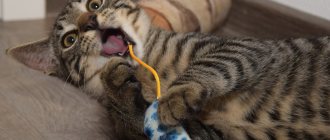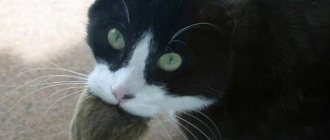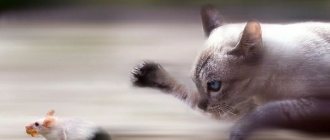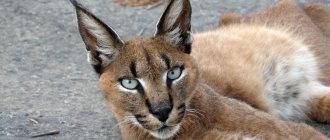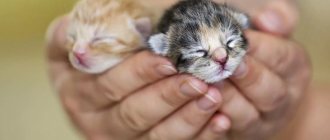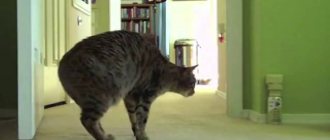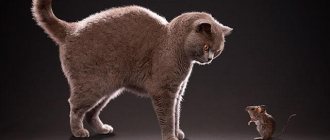When it comes to catching mice, no innovative device can compare with a smart house cat. Fluffy pets have won the love of humans thanks to their ability to destroy rodents. Today, breeders keep cats for the hobby, so pets usually lead a passive lifestyle. For people living in rural areas and having a subsidiary farm, it is important that the cat knows how to catch mice and rats. Rodents periodically appear in every country house and are capable of destroying food and causing diseases. Which cats are better at catching mice, and which breeds are not suitable for hunting?
How to teach a cat to catch mice?
Mousecatchers are found among purebred and outbred cats.
In order not to make a mistake, it is recommended to figure out in advance what criteria to choose a kitten by. Attention is paid not to the physical structure, color or breed, but to the parents. If the father or mother is good at catching mice, they will teach the kitten the skill
Therefore, you should first ask the owners how good hunters the parents were. A reasonable option is to go to the nearest village to pick up the kitten. Animals growing outside chase flies, butterflies and other insects, which develops the hunting instinct.
It is difficult to teach a domestic cat to hunt; the instinct must be developed from childhood. The owner needs to purchase appropriate toys, lined with fur, and constantly tease the kitten so that he runs after them. You should develop your pet's agility, reaction speed, coordination and endurance. To attract your pet's attention, the toy can be soaked in a decoction of catnip. As an alternative, you can catch the mouse and show the rodent to your pet. The kitten will interest her. You can only remove a mouse when the animal has had enough of playing with the pest and strangled it.
Nutrition
Even if a cat successfully hunts and does not return home without prey, it still needs to be fed, and fully, but most importantly - correctly. The physical condition of the animal - strength and endurance - depends on a balanced diet.
In a good half of cases, pets do not eat their prey, but strangle it: they bring it to the porch to show respect to the owner, or give it to kittens to learn the hunting craft. Street cats feed on caught mice, and other reasons, such as games, fade into the background.
It is better to give preference to natural products or good industrial feed. It is very important that the food provides the animal’s body with all the necessary minerals and vitamins. A balanced diet will have a positive effect on both your pet’s immunity and its activity.
By what signs can you recognize a rat catcher?
A mousetrap cat is not a breed, but a rare skill that a pet develops due to the conditions of its keeping and upbringing. The best hunters are considered to be mongrel cats, who have had to hunt mice for food since childhood.
Street animals are not spoiled by the attention and care of the owner, so the hunting instinct develops and remains for the maximum period
The following signs will help you recognize a future rat catcher in a kitten:
- if one of the parents is good at catching mice, by four months the skill will be transferred to the kitten;
- female. Cats catch mice better than cats, which is associated with increased activity and fearlessness. To feed her offspring, the mother cat will get food in any way, so her hunting instinct is heightened;
- head shape. Animals with a triangular oriental skull shape have greater potential for catching rats;
- activity in the game. If a kitten runs after ribbons, toy mice and catches them with his teeth, he will make a good hunter;
- physiological characteristics. The pet must be well built, have developed muscles, strong bones;
- high ears with tassels. Allow the pet to track rustles and squeaks, which increases the likelihood of finding a target;
- color feature. It is believed that the best hunters are tri-colored, tortoiseshell, and motley cats.
The listed signs increase the likelihood of a successful hunt. But the development of the skill depends on the conditions of detention and upbringing. If you keep your pet in an apartment and give it food when called, the hunting instinct will “die out.”
Heredity and upbringing
Numerous studies prove that a kitten's hunting abilities are influenced not only by heredity, but also by upbringing. If the baby had free access to prey, and his mother taught him to catch mice, then he will become a good hunter, regardless of breed or lack thereof. Of course, if you add to this the need to get your own food, your abilities will develop even better.
Good heredity
And yet heredity is very important in the formation of real mousecatchers. If all ancestors caught mice, then most likely this skill will pass on to kittens. But the most important role is played by the mother, she is the one who helps babies develop the hunting instinct, turning it into a skill. The mousetrap cat begins to train kittens from an early age, and they adopt all her experience by about 4-5 months. So before this age you should not take the baby away from its mother.
How to raise and teach a cat to catch mice?
The future mouse catcher's hunting skills need to be developed from early childhood. Usually the mother does this. It all starts with the cat catching a live mouse and bringing it to the kids. Later, the kittens begin to hunt on their own, first under the supervision of their mother, then alone.
But you can try to teach your kitten to catch mice yourself. To do this, use active games, special toys, or another effective option - walks, during which the kitten can catch frogs, beetles or butterflies. Every time the baby catches prey, he should be praised.
It is very important to remember that you cannot force a cat to catch mice by starving it. The animal will weaken, become lethargic and will no longer have the time to hunt. There is a high probability that the cat will begin to climb through garbage dumps in search of food. But it is important not to overfeed the cat so that he remains active.
Production
If a cat has the makings, and the training has borne fruit, then pretty soon you can see your pet eating its first mouse.
Why do cats bring caught mice to their owners?
An interesting point is that a cat does not always eat caught mice. For many mustachios, the hunting process is much more important and interesting, and they prefer to eat their usual food. Quite often, strangled or slightly chewed rodents end up on the windowsill, on the threshold, or even by the bed of their beloved owners. There are several explanations for the fact that the cat did not eat the mouse, but brought it to the person:
- Many cats perceive people as clumsy creatures who lack even the most necessary skills. By bringing us prey, the pet shows concern so that its human does not die of hunger.
- The cat is proud of itself, hopes for recognition and praise, or wants to please its owner.
- The animal stores food for the future and believes that food will be safer in the house.
In any case, the appearance of a dead mouse in the house should be taken calmly, and the cat should be praised and thanked. You can throw away a gift only when the pet does not see it, otherwise resentment on his part cannot be avoided.
Who is better at catching mice - a cat or a cat?
Both male and female cats catch and eat mice. But females are considered the best hunters. They have a more developed hunting instinct, while males are more focused on finding a partner and procreation. A cat needs to provide food not only for itself, but also for its offspring.
A fairly popular question is which cats are better at catching mice - neutered or not. Castration does not affect the hunting instinct in any way, but as practice shows, it often affects the animal’s lifestyle. The cat becomes lazy and avoids any active actions, which naturally negatively affects his hunting abilities. Interestingly, the habits of a sterilized female usually do not change.
Who is better at catching mice, a purebred cat or a barn cat?
Both purebred and barn cats have this instinct in the same way. In more reliable hunters it is better expressed. If we consider a purebred cat, then in the course of their evolution, breeders tried to lull the cats’ natural instincts in order to better adapt them to life in an apartment. Therefore, such a cat will catch a mouse, but only out of curiosity, and not in order to eat or kill it.
However, this does not mean that outbreds catch mice better. Especially if they were bred in apartment conditions and have never seen rodents. And even if such a cat does come across a rat or mouse, it will simply play with it, not suspecting that a real hunter should bite it in the back of the head to kill it. And good hunting requires skills.
How to teach or instill in a cat the ability to catch rodents well?
An experiment conducted back in 1960 will help answer this question. In which four cats took part: two purebred and two ordinary hunters. All cats were bred with cats similar to them. After the litter appeared, the kittens were changed, the hunter-murks were given purebred ones, and the purebred ones were given ordinary ones.
After three weeks of age, ordinary hunting cats brought a mouse to “their” kittens and taught them to handle it with special care and precision. At this time, ordinary kittens from “their” purebred mothers learned only games, hunting was absent from their lives
During the experiment, it became clear which cats would be the best hunters - those that lived in special conditions and had experience in catching mice. Therefore, with all the cat's heredity, growing conditions play a key role.
This means that in order to choose a mouse exterminator, you need to know how the kittens were kept.
A kitten from the street or born in a basement is very suitable for this role; from three to five months of age it is already ready and has all the necessary skills for hunting.
If we talk about purebred representatives, then you need to know in what conditions they were raised - if in a suburban area with access to the street, and not in an aviary, then the following breeds are well suited: Russian Blue, Siberian, Kuril Bobtail, Bogatyr - Maine Coon, Bengal .
Appearance of the ratcatcher cat
Which cats are better at catching, judging by their appearance?
Short-haired representatives are considered the best hunters, because with a little rain, the long hair gets wet and begins to smell strongly, which scares off potential prey. And the wool should be appropriately colored: dim stripes and spots, i.e. wild color, it’s easier to blend in with the world around you.
If the pattern is monochromatic, then not bright colors will do: it will not be easy for a white cat to catch a mouse, but for a red, gray, or black cat it will be easier to merge with nature. Our grandparents also say that the more mustachioed the cat is, the more he will catch.
By gender
The sexual instinct of cats interferes with the hunt a little; he would like to find another bride for himself, that’s what’s first in his head. Cats come into heat almost every month. If she gave birth to kittens, she devotes almost all her time to them. But then he is an excellent hunter. Therefore, the cat is probably more diligent, more diligent, and more successful than the cat. And if she is also sterilized, then this is generally wonderful, less thoughts about offspring and walking, more about hunting. Castration of a cat will also correctly influence the right thoughts about hunting, although if before castration he did not particularly like to run after rats, then after that he may not wake up particularly zealous.
Hunger is not a thing...
Why does a cat catch mice? Well, probably to eat? It turns out that if the cat is not fed, it will catch better and catch more? Logical, but not correct. Cats do not catch mice for food. Regardless of whether she is full or not, she will catch the same. For her, fishing is not a way of subsistence, it is something like a game. She needs the fishing procedure itself. And eating is already a nice bonus to the game. By the way, they love simple mice, but they simply kill moles and rats.
Beware the mouse is poisoned
A cat that catches mice every day is at risk of contracting viruses and parasites carried by rodents. Therefore, the owner of a rat-catcher cat should not skimp on vaccinations and other preventive measures.
Apartment trappers are also at risk: the mouse can be poisoned by arsenic or other poison, which can lead to severe poisoning or even death. Allow your cat to eat the mouse only if you are sure of its “purity”.
Analysis of the dilemma
Every cat is endowed with a hunter's instinct. To do this, you can carry out a simple check. You need to scrape your nails along any rough surface. How does the cat behave at this moment? The faster her reaction to this action, the more serious the possibility that she will begin to catch mice. The reaction may include wiggling the ears and throwing towards the hand.
If a cat was born in an apartment and grew up in an urban home environment, then it will not catch rodents . If in some situation she sees a mouse, she may simply play with it, rather than perceive it as prey. Simply instinct is not enough here. It also takes practice.
A true cat-hunter is very enthusiastic about this matter. She won't stop until she kills her victim. Usually followed by a precise bite to the back of the head. Only a mother can teach these skills. For this reason, cubs raised in yards or basements are good at hunting this way.
© shutterstock
Character and behavior of lop-eared animals
The Scotsman is a purebred cat that is distinguished by its kind disposition. Distinctive behavioral traits:
- communication skills and sociability;
- love for children;
- gaiety;
- easy to educate with the right and friendly approach;
- actually cannot be trained;
- playful;
- not mischievous;
- they quickly forget bad things and do not take revenge.
Scottish Folds are an ideal option when there are other animals and children in the house. Such kittens are real aristocrats with their mannerisms and waywardness. Their restiveness and capriciousness are often observed. If the Scots want something, they will definitely achieve it. An adventurous breed with a curiosity for the unknown. When new people appear on their territory, Scottish cats are not very friendly, but then they begin to communicate. Scots love to play, but are not particularly happy with cuddling and cuddling.
Kurilian Bobtail
Bobtails are quite large animals, capable of rivaling Maine Coons in size. The weight of a cat can reach 10 kg, and that of a cat - 6 kg. The homeland of this breed is the Kuril Islands. Difficult living conditions raised them to be brave and strong hunters. They have a short tail and strong legs, providing excellent jumping ability. Bobtails cope with both mice and large rats.
Among other breeds, the bobtail is distinguished by its sociability and easy-going character. They readily make contact with humans, are easy to train and get along well with other animals, including large dogs. This makes them similar to another “tailless” cat - the Manx cat
, which also has a friendly disposition combined with excellent hunting skills.
Kurilian Bobtail
Manx cat
By what external signs can one identify a future mousetrap?
It is believed that a cat that can successfully catch mice must look the part. What signs can be used to determine which kitten will be an excellent rodent exterminator?
Signs of a mousecatcher:
- long mustache;
- wild color - black, red or gray, two or three colors, with faint stripes and spots to blend with nature and remain invisible to its prey;
- short hair – long and thick guard hair when wet acquires an unpleasant odor, which can scare away the rodent;
- large ears and triangular head;
- large paws.
They tried to choose the best rat catcher using these signs several decades ago. In reality, there are no perfect rat hunters. Every cat has a hunting instinct from birth, but not all representatives of the feline family realize it with equal success.
Before you take a kitten into your home to catch mice, you should ask whether its mother was a good hunter. When raising their cubs, cats pass on their skills to them, including in catching rodents.
If the pet was taken from the street, it is highly likely that its hunting skills will be well developed. In purebred pets, the instinct is dulled, especially if several generations of animals have lived in apartments and do not even know what a mouse or rat looks like.
Is it possible to teach a cat to hunt if she doesn't show much desire to catch mice? In order for the animal’s natural instincts to awaken, it is necessary to let the pet feel a slight feeling of hunger. A cat should not be completely deprived of food - this is cruel and fraught with health problems. You just need to reduce the portion size: malnutrition will awaken the instinct in your pet. After the first successful hunt, it is advisable to reward the animal.
You need to teach your pet to hunt from childhood. There is no point in training an adult castrated cat. The purpose of its existence is food and sleep, such animals become lazy and quickly gain excess weight, and it becomes more and more difficult for them to run every year. But you can and should awaken a kitten’s interest in hunting. To do this, catch the mouse using a mousetrap and let your child play with it while it is still alive.
To activate the kitten's hunting instinct, you should play with it more often using a laser pointer or special toys. If your pet tirelessly chases them, he will become a professional in catching mice.
Sterilized individuals
Some are convinced that castration in no way affects hunting instincts. But sterilization does not pass without a trace and affects not only the physiological part, but also the behavioral part.
After castration, the pet becomes more passive: it sleeps longer, is lazy and has little interest in what is happening around it. Moreover, after the procedure the animal is prone to gaining excess weight, which affects its mobility.
After castration, veterinarians recommend choosing a special diet for your pet that is low in fat, as well as elements that stimulate activity. On sale you can find special food for sterilized cats, which facilitates the physiological adaptation of the animal.
How to determine if a cat is a rat catcher?
Future owners of furry pets are often interested in which cats are better at catching mice. There is no specific breed that would be designed specifically for catching rodents. However, there are signs by which it can be determined that an animal is predisposed to this. In addition, there are more than one breed of cats that can catch mice and rats.
Animals born and raised in apartment conditions are not always able to cope with catching rodents. The best hunters are cats and cats that grew up on the street. They have well-developed natural instincts and animal habits.
External signs that rat-catching cats should have:
- Large and dense build.
- Long, “L-shaped” tail.
- Short and wide legs.
- Powerful jaws with fangs.
- Long mustache.
- The head is shaped like a triangle.
- The ears are large, with possible tufts at the tips of the ears.
These are the most characteristic signs that allow you to understand that the kitten is a rat catcher. Once the external characteristics that rat-catching cats possess are known, it is worth considering the breeds.
Maine Coon
These luxurious, large (weighing up to 15 kg) cats come from America, more precisely the state of Maine. They were specially bred to exterminate mice and rats on farms and ships. Despite their impressive size, Maine Coons are agile and agile. Large ears provide them with excellent hearing, and strong paws provide them with a good grip.
Thick, long hair allows the Maine Coon to live in harsh climates. But it also creates problems for the owners. The fact is that these cats need to be brushed regularly. If you leave the animal to its own devices, the magnificent fur will quickly become tangled and no longer protect against the cold.
The disadvantages of Maine Coons include gluttony (which should not be surprising, given their size) and independent character. These natural hunters are not particularly interested in constant human contact. They shy away from petting that they consider inappropriate, and if the owner is too intrusive, they can get angry and bite.
Ratcatcher cats need regular, long walks to stay in good physical shape.
Cat or cat: who is the better hunter?
If we talk about the gender of mousecatchers, it still seems more reasonable to give the palm to the cat. In cats, the sexual instinct comes first, and if the animal is not castrated, the mustachioed cat can be distracted by “love” all year round, neglecting his hunting duties. We have all seen how skinny and tattered the tailed gentlemen return from their sexual adventures - it is obvious that they had no time for mice.
In cats, the estrus period is usually not long. And, raising kittens, as we said above, they hunt with double zeal and teach their offspring to do so. That is, they have double motivation. And female creatures usually have more persistence and diligence.
Hunting instinct in cats
Despite their small size and very long stay as pets, cats remain predators. The ancestors of modern cats were good hunters, because this was the only way they could get food for themselves and their offspring, and therefore survive and raise their cubs. The hunting instinct remains one of the main ones in cats to this day. By the way, this is exactly what appears in a small kitten chasing a toy.
Hunting
Breeds of rat-catching cats
There are certain breeds in the cat family, whose representatives are distinguished by excellent health, special dexterity and dexterity in catching rats.
Siberian cat
The cat was named Siberian due to its fluffy long hair. She is unpretentious, has a strong build, the weight of cats reaches 7 kg, cats weigh about 9 kg. She has strong paws and excellent grip. Due to the slightly longer hind legs compared to the front legs, the cat has the ability to run and jump quickly. Such animals are obstinate in nature, they have an excellent reaction, which is necessary when catching rats. They are independent and love freedom.
The Siberian cat has a strong build and excellent grip.
Maine Coon
Cats of this breed are distinguished by mobility and strength. Maine Coons are hardy and able to live in regions with harsh climatic conditions. These large animals (males can weigh up to 15 kg) have the nature of a predator; they do not welcome human affection. Due to their size, they can easily deal with rats.
Maine Coons easily deal with rats
This breed of cat is distinguished by straight-set large ears, which have tassels at the ends. Maine Coons have long and thick fur. They have well-developed muscles, a wide chest, strong bones, and a thick and long tail. All this data allows Maine Coons to become a real threat to rodents.
Kurilian Bobtail
A feature of animals of this breed is a short tail, the length of which does not exceed 3–8 cm. But they have strong hind legs, which are longer than the forelimbs. And therefore the Kurilian bobtail runs well, jumps, and deftly strangles rats. Males of this breed weigh about 10 kg, females - 6 kg.
The Kurilian Bobtail is fearless and deftly strangles rats
Such cats are capable of completely destroying a mouse or rat hole. They are easy to train and can be trained. People keep them as companions; they get along easily with other animals. Bobtails have a fearless character.
European shorthair cat
Representatives of this breed destroyed rodents back in the days of Ancient Rome. European shorthair cats are called yard cats and are not considered purebred. However, they are popular in the world and are one of the best rat catchers. The predator's passion and agility help them successfully hunt rats and mice.
European shorthair cats are some of the best rat catchers.
Such cats are distinguished by individuality, independence, grace, and aristocratic appearance. They have a short coat, gray or silver marbled in color.
Cymric
Animals of this breed are similar to ordinary cats, but with a short tail. This structure, along with agility and tenacious claws, makes the Cymric a successful rat catcher.
Agility and tenacious claws make the Cymric a successful rat catcher.
British Shorthair
The hunting instinct and excellent natural inclinations make the British excellent rat catchers. Such cats are calm, friendly, and attractive in appearance. They love to please their owner by bringing him a caught rodent in their teeth in order to exchange it for rewards and something tasty.
Natural inclinations and hunting instinct make British Shorthairs excellent rodent catchers.
Females, weighing an average of 4 kg, try not to attack large rats, hunting only young ones or mice. Often this is enough to avoid a rodent infestation.
Russian blue
Russian blue cats are medium in size and light in weight, but this does not interfere with their hunting habits. Instant reaction and silent movement for a long time make these cats good rat catchers.
The Russian Blue cat has the ability to move silently and react instantly.
The ability of the Russian Blue to react to rodents is a true art: its speed of attack on the prey, accuracy and grace of movements are captivating. This is a thunderstorm of super rats, weighing about 500 g. The Russian Blue does not like partners of other cat breeds, but gets along well with rat catchers of its own breed. Opponent of tenderness from the owner.
Russian blue cat
This is a real aristocrat among rat catchers. Russian blue cats were kept at court by many royals, for example, Peter I and Catherine II. Centuries later, these graceful, smooth-haired animals remain excellent hunters. They can handle not only mice, but also rats weighing up to 0.5 kg!
It is worth noting that Russian Blue cats do not get along well with representatives of other breeds, but get along well with their own. Like many other predators, they are not particularly susceptible to affection, but at the same time they treat people with sympathy and rarely show aggression.
Please note - a lazy, barely mobile cat cannot become a good rat catcher.
Behavior change
There are often cases when cats behave quite aggressively towards household members and guests. Pets are capable of not only scratching furniture, but also attacking. The animal experiences a kind of stress (usually due to dissatisfaction). This behavior goes from episodic to permanent status, since the pet considers it the norm.
The problem can be solved if the animal is sterilized in a timely manner. The cat becomes more accommodating as the source of “indignation” ceases to be relevant
If even several months after the operation the cat still continues to be mischievous, then the cause should be sought in other factors (constant stress, illness, lack of attention, etc.). In the first days after the operation, the animal may behave too calmly
It will seem that in such a short period of time the pet's activity will decrease significantly. But actually it is not. The rehabilitation period for each individual is different. For some, a couple of days are enough to recover, while for others it takes up to several weeks or even months.
The main thing is to provide your pet with complete care. This applies not only to nutrition, but also to attention. After all, the animal needs the support of its owner more than ever.
It is important to find that “golden” mean that will be optimal for creating a postoperative environment for a cat
How to raise a hunter
Even breeds in which the hunting instinct is very pronounced, or with heredity conducive to this, will not necessarily become excellent hunters without the proper conditions and education
To help develop it, we recommend paying attention to the following techniques:
Encouragement always plays into the hands of teachers. Praise your pet when he catches prey (but not, of course, if his prey was one of your other pets); One might assume that if an animal has nothing to eat, it will inevitably become a hunter, but this is not so. If you start starving your cat, most likely he will start stealing and searching garbage dumps, but will not join in the hunt. Feed your pet often, but in small portions. The bowl should not be kept full all the time; Games are a good stimulant
By playing, you will help the kitten develop the hunting instinct, but you should not get too carried away with this, because by fully satisfying the need for hunting with fun, you can discourage the cat from switching his attention to mice and other pests. As one of the options for developing the hunting instinct, you can use a live mouse, which you yourself will give to the kitten
You can pick it up only after the pet has played with it and strangled it.
Little hunter
The optimal age at which you can take a kitten from its mother is four to five months. By this time, your pet can already learn the basics of hunting science from its parent. Also, the future hunter needs to be constantly vaccinated, including against rabies, treat the fur with sprays, buy a flea collar and periodically treat for worms, since as a result of hunting your pet may become prey to various parasites.
Recommendations
A hunting cat spends a lot of time outdoors, in contact with other animals, which increases the likelihood of infection and the development of diseases. To protect your pet from diseases, you need to remember the following rules:
For preventative purposes, you can take your cat to the veterinarian for examination once every six months.
How to identify a ratcatcher cat
The first thing you should pay attention to is the color of the animal. Representatives with gray, black, brown, red skin blend better with nature and, as a result, are more successful hunters
White, unfortunately, in this case, is the most losing.
The second point is education
It is very important how the kitten behaved in childhood. Outdoor games with a bow, a ball, chasing the light of a laser pointer - all this is the preparation and development of hunting instincts
In addition to these important points, rat-catching cats also have the following features:
- Scientists, veterinarians, and breeders note the fact that there is a well-defined gender difference in the manifestation of the hunting instinct in cats. Cats are considered more effective rat catchers than cats. The thing is that by nature, females have the understanding that they must feed not only themselves, but also their offspring, therefore, in terms of obtaining food, they act more actively and consciously.
- Those cats that catch mice and rats differ from their counterparts in the shape and structure of their heads. It is believed that animals with a skull whose outline is close to triangular are more capable of hunting than others.
- The presence of high tufted ears and a bushy mustache is another sign of a rat catcher. This anatomical structure ensures high sensitivity: the hairs react to any, even the slightest, air vibrations.
- The breed of rat-catcher cats is of great importance. In this matter, you cannot choose artificially bred representatives. Such selection has a negative impact on skills and dulls natural instincts.
Interesting! Yard cats and female cats are excellent mousecatchers. The point is also that they develop their instincts from childhood. Hunting for them is a way to survive.
An equally interesting question is whether the rat-catcher cat will continue to hunt after castration. The animal's behavior changes after this operation, but this does not mean that it will lose its innate and developed instincts. The only thing you should be careful of in this situation is overfeeding your pet. Such measures often lead to obesity, and, as a result, hunting skills decrease. Therefore, a neutered cat should be given a special diet, so that he will continue to perform the task assigned to him.
Some rat hunters may be affectionate in nature, while others may be unsociable. There are animals that want to please their owner and often catch rats to show him their love. And there are cats that avoid people and do not welcome affection, but this is also quite normal.
European shorthair cat
Small smooth-haired animals of gray striped, spotted or marbled color are considered to be outbred. But these “plebeians” caught rats and mice back in Ancient Rome. The European Shorthair cat is a strong, agile and intelligent animal. She loves and knows how to hunt, and at the same time has good contact with people. However, if you pick up a mongrel kitten on the street, you shouldn’t hope that it will start exterminating rats left and right. As a rule, private breeders or nurseries are engaged in breeding really high-quality rat-catcher cats, and often there is a queue for offspring almost a year in advance. If you want such a cat, look for trusted breeders with recommendations, but remember that it takes 4-5 months for a mother to teach her cub predator skills, so you should give preference to older kittens.
Ratcatcher cats can catch rats, mice, snakes and moles equally well, but they will also calmly deal with domestic animals - ducklings or chickens. Therefore, it is important to raise the animal correctly from the very beginning.
Popular rat catcher breeds
A cat's tooth fell out: main symptoms and treatment options
As already mentioned, in the matter of choosing an animal for catching rodents, the breed is not the least important. There are a number of felines that are endowed with a strong hunter gene. If we consider purely physical data, they will differ in the above characteristics.
Russian blue
One of the most prominent representatives. The Russian Blue is not one of those who will sit in ambush for hours and watch its prey. She attacks quickly and swiftly, almost always overtaking her target.
Russian Blue has a good upbringing. A cat will rarely allow itself to scratch furniture and wallpaper, or stir up flowers. Representatives of this breed have a good memory. Having learned to hunt once, they will do it constantly.
Russian blue
Siberian cats have good health, well-developed muscles, powerful paws and an elongated neck. Their thick, long fur has a dark, striped color. These are one of the few long-haired representatives that are excellent hunters.
Siberian cats easily and quickly overtake their prey, and their long claws do not allow it to escape. They are very patient and can stalk their prey for hours, waiting for the best moment.
In relationships with people they prefer to maintain a distance. They are not as trusting and attached to humans as other breeds. The Siberian cat easily gets used to any change of environment, therefore, even if the pet is moved to a private house, it will quickly get used to it there.
Important! The Siberian breed does not require special care. A distinctive feature is that they need regular walks in the fresh air (even in winter)
Maine Coon
The Maine Coon is a breed that was originally bred to control rodents and other pests. The main advantage is their size. Such dimensions help to fight even the largest enemy. They are fluffy and come in a wide variety of colors. A characteristic feature of this breed are medium-sized straight ears with a tassel at the tip.
For your information! The most interesting thing is that Maine Coons can get along with domestic rodents (like hamsters), but at the same time catch pests.
Maine Coons do not like confined spaces; they need freedom, a place to play and run. Therefore, it is best to keep such large animals in a private home. It is also worth remembering the special care that representatives of this breed require.
Cymric is not known for its large size. The main difference is that they almost completely lack a tail. This feature resulted from incest. However, such moments do not prevent Cymrik cats from being the best hunters. Experienced breeders recommend keeping representatives of this breed in spacious premises. This is exactly what a private home is, where they can fully realize their potential and splash out their energy.
Despite the lack of a tail, the Cymrik is distinguished by a very agile body and long llamas. The hunter quickly and easily overtakes his prey.
Note! Cymrik has been a rat catcher since birth. Cymric
Cymric
Representatives of this breed are often confused with yard murziks. According to historical data, the European Shorthair comes from Ancient Rome and even then established itself as an excellent hunter.
The color is silver marbled or gray. They love a lot of space, but can live in a city apartment. Quite unpretentious in care.
Important! They prefer to keep their distance from other animals and children.
Kurilian Bobtail
Representatives of this breed appeared in Russia relatively recently (at the beginning of the 20th century). These animals were brought from the Kuril Islands. Very affectionate and devoted to people. Their character traits are reminiscent of dogs.
We invite you to familiarize yourself with Antique Bathhouse Finishing
Why are they good hunters? Precisely because of his affection. Even as a kitten, the Kurilian Bobtail tries in every possible way to please its beloved owner. Therefore, it is worth preparing for the fact that all the caught prey will be brought home and demonstratively eaten.
The breed is distinguished by a small tail and body, similar in structure to a lynx. The hind legs are longer and more powerful, which allows them to quickly gain speed when chasing prey.
Kurilian Bobtail
Characteristics of rat-catching cats
There are several basic signs that allow you to determine how good a rodent hunter a cat will be. Among them:
- head shape (felinologists have found that the best rat catchers are animals whose skull outlines resemble a triangle);
- muscular body with strong paws;
- protruding ears with tassels;
- bushy mustache;
- powerful jaw;
- variegated, usually three-color coloring (helps with camouflage);
- short hair (in wet weather, long hair emits a stronger odor that rodents can smell from afar).
But cats eating rats or simply catching them, obeying instinct, is unlikely to affect the hunter’s talent. Character is also not a decisive factor - rat catchers can be affectionate and playful, or they can behave with restraint and even sternness. But of course, a good hunter must be brave and decisive, because a cornered rat can even attack a cat.
Situations have been recorded where a rat killed a cat by grabbing its throat. True, such situations occur extremely rarely; more often the rodent tries to escape.
Questions about breeds and external characteristics.
As has already been noted, the best mousecatchers are cats raised in appropriate conditions.
Although some experts insist that there are still breeds of mousecatchers. These are all European cats with short hair. In this category, the following are distinguished by color:
- European tabby. Outwardly, it resembles a small tiger. Cats of this breed are very strong and stocky. They don't just catch mice, they ruthlessly destroy them.
- European speckled. These are good mouse hunters of various parameters. They also catch lizards, snakes, small birds and fish.
shutterstock
Pet's appearance
The color and quality of the coat plays a significant role for the animal when hunting rodents. Hair is a cat's natural camouflage. Individuals with a dark and discreet color are in a more advantageous position in contrast to pets with bright colors, for example, red. Those with a tortoiseshell coloration are better at catching mice, unless, of course, they hunt on snowy ground.
Another critical point is the length of the coat. Moistened hair emits a specific odor that rodents can smell, which is especially important when hunting in rainy weather. Naturally, short-haired individuals have much less problems with this.
Whiskers are an important tool in animal hunting. Thanks to them, the pet determines the distance to the victim and orients itself in complete darkness. Therefore, when choosing a mousetrap, it is worth inspecting the mustache for damage.
